2020 has provided many challenges and trials, but despite the pandemic, UK Research and Innovation (UKRI) still played its part in this year’s International Year of Plant of Health (IYPH).
It has shown just how important plant health and plant research are for the future.
Throughout the year we collaborated with 12 artists from across the country to bring you a new piece of artwork each month. The artwork that represents a plant health threat, issue or research project.
Potato
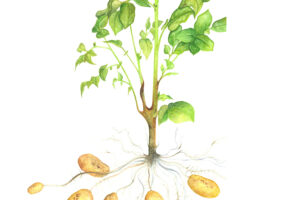 Potatoes are the most important non-cereal crop in the world, and are a good source of several micronutrients as well as carbohydrates.
Potatoes are the most important non-cereal crop in the world, and are a good source of several micronutrients as well as carbohydrates.
However, they’re vulnerable to a changing climate, heat stops them growing and flooding stops them being harvested, as well as diseases like potato blight.
UKRI-funded research (Biotechnology and Biological Sciences Research Council (BBSRC)) has looked at the impacts of recent weather (YouTube) on crops and how we breed potatoes that can handle changing temperature.
The research found that protecting the UK’s crops, allowing them to be grown in warmer climates, and developing potatoes that are resistant to late blight all reduce the number of crops lost to disease.
Karen Green, a botanical and watercolour artist from Gloucestershire said:
As a botanical artist I am fascinated by the wonders of plants, their botany, behaviour, folklore and uses in health and medicine. The potato plant provides the ‘mighty’ vegetable so stands tall and proud with its golden nuggets of joy at its roots.
Wheat
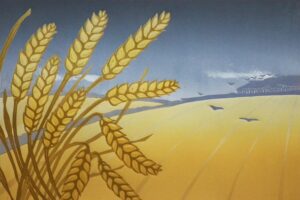 Wheat provides 20% of the calories consumed by people worldwide, and is a key source of plant-based protein in some parts of the world. Protecting its health is absolutely vital. Diseases like take-all and wheat rust cause severe losses worldwide.
Wheat provides 20% of the calories consumed by people worldwide, and is a key source of plant-based protein in some parts of the world. Protecting its health is absolutely vital. Diseases like take-all and wheat rust cause severe losses worldwide.
One of the challenges to developing disease-resistant wheat is finding the right genes in its mind-bogglingly complex genome.
Research is helping us to navigate wheat’s genome with a view to making further improvements to disease resistance.
Beth Jenkins, artist and printmaker from Gloucestershire said:
I am very concerned about the threats to the many species of plants that are part of our landscape and our food chain, as well as being habitats for many creatures.
For the wheat print, I chose to use the colour contrast of a stormy sky against the vibrant colour of the wheat because of the visual impact this creates.
Rice
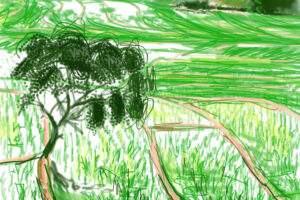 Rice feeds billions of people across the world. It’s a major food source and export product in official development assistance countries, and also a common subsistence crop.
Rice feeds billions of people across the world. It’s a major food source and export product in official development assistance countries, and also a common subsistence crop.
In many Asian countries, people greet each other with a phrase which translates as “Have you eaten rice yet”, underlining its importance in life. Unlike wheat, which is grown for humans and as animal feed, rice is grown exclusively to feed people.
UKRI supports many collaborative research projects with rice-growing countries to develop improved rice plants that are better able to withstand climate change (Gateway to Research (GtR)), or pests and diseases.
Andy Maitland makes digital drawings on an iPad using a stylus and the drawing app ‘Brushes’. He lives and draws in Surrey. His drawings are made directly from observation, usually outdoors.
I like my greens, and not just as an artist! Like many people, I’m eating more plants than ever before, for my own health as well as for the environment. Plant health has never been more important. I’m thrilled to be involved in highlighting the International Year of Plant Health 2020.
Black grass
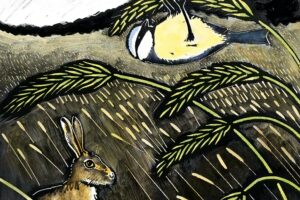
Black grass is a major weed that grows in wheat fields in the UK. It damages wheat health by competing for soil nutrients.
There are serious problems with herbicide resistance in black grass.
In a study (Black-grass Resistance Initiative), 79% of the tested black grass samples were resistant to all herbicides tested, and resistance to glyphosate may also be evolving. The study was funded by BBSRC, part of UKRI.
The aiScope project is funded under the UKRI Challenge Fund Transforming Food Production programme (TFP).
Andrew Mclay from the TFP programme explains:
Blackgrass is reported to cost UK farmers over £500 million a year.
The aiScope project combines practical farming expertise with big data analysis and artificial intelligence experience from International Business Machines to identify the most effective combinations of methods for controlling blackgrass across the UK.
The aim is to deliver tailored management solutions to farmers for their specific farm situation.
This may also reduce herbicide use which is good for the environment and biodiversity.
The artist is Frank Duffy, a designer and illustrator from South Wales.
Strawberries
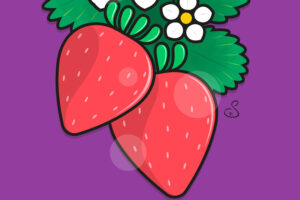 Strawberries are part of a booming soft fruit industry. As well as being tasty, red or purple coloured fruits contain antioxidants, which are beneficial to our health. Plants that produce edible fruits around the world are under threat from pests and diseases.
Strawberries are part of a booming soft fruit industry. As well as being tasty, red or purple coloured fruits contain antioxidants, which are beneficial to our health. Plants that produce edible fruits around the world are under threat from pests and diseases.
Research and innovation is helping to create new methods of treating disease in fruit-bearing plants, and even advancing methods like indoor growing to keep crops such as strawberries safe from these threats.
In a joint UK-China research programme, National Institute of Agricultural Botany East Malling Research (NIAB EMR) has discovered several strains of the strawberry disease Verticillium wilt (Verticillium dahliae).
They belongs to two different groups, that act in very different ways.
Dr Richard Harrison, Head of Genetics, Genomics and Breeding at NIAB EMR in Kent, says:
Our strawberry breeding programme produces globally important new varieties. Using this exciting new knowledge, we can choose the right parents to generate the next generation of wilt-resistant varieties for a worldwide market.
Stina Jones is a freelance illustrator and graphic designer based in Manchester. She produces graphics for everything from print and web marketing campaigns, through to animations and exhibitions, with a focus on for colourful illustrative designs.
Arabidopsis
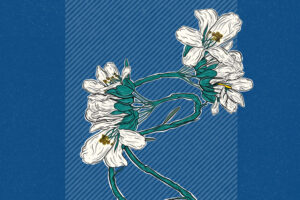 Arabidopsis thaliana is a small flowering plant that has been widely used as a model organism in plant biology for several decades.
Arabidopsis thaliana is a small flowering plant that has been widely used as a model organism in plant biology for several decades.
The use of Arabidopsis as a model organism was pioneered by the former Plant Breeding Institute, which was funded by BBSRC’s predecessor (Agricultural and Food Research Council).
Its relatively simple genetics and ability to grow in a lab environment has made it easy for researchers to test ideas and make discoveries about plant genetics. These can then be applied to plants we use in our everyday lives.
A team of scientists has revealed a new, sustainable way for plants to increase carbon dioxide (CO2) use for photosynthesis while reducing water usage.
Studying Arabidopsis, the engineered plants demonstrated improved growth and biomass production while also conserving water.
Professor John Christie, Professor of Photobiology at University of Glasgow, said:
Our findings demonstrate the feasibility of improving the efficiency of water use by plants while making gains in photosynthetic CO2 assimilation and plant growth.
The artist is Joseph Carpenter, a Stroud-based illustrator who creates everything from gig posters to magazine covers.
Maize
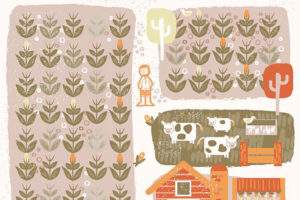 Maize (called corn in some countries) is Zea mays, a member of the grass family Poaceae. It is a cereal grain and is now the third most important cereal crop in the world.
Maize (called corn in some countries) is Zea mays, a member of the grass family Poaceae. It is a cereal grain and is now the third most important cereal crop in the world.
However, little of this maize is eaten directly by humans. Most is used to make corn ethanol, animal feed and other maize products, such as corn starch and corn syrup.
Maize has been a useful model organism for research in genetics for many years. Nobel Prize-winning scientist Barbara McClintock studied it in the 1940s to 50s and discovered ‘transposition’, the movement of whole sections of chromosomes.
Research has shown that artificial selection was used to develop maize from a Mexican plant called Teosinte.
Leeds-based Buttercrumble is a creative communications studio formed by twin sisters, Chloe and Abigail Baldwin.
Chloe Baldwin said:
I was eager to take part in the campaign because it’s a once in a lifetime opportunity!
I illustrated an aerial view of a maize field to demonstrate the broad amount of unique benefits that maize brings. It nods to the way maize is used as silage for animal feed and how its increasingly being harnessed for gas for fuel production.
Lavender
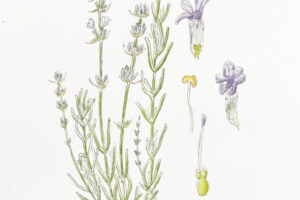
Lavender is a one of many hosts of devastating bacterial plant disease Xylella fastidiosa, which is currently having a devastating impact on olive trees in Italy.
Movement of plants and plant material around the world plays a major role in introducing new diseases to plants that have never encountered them before, a recipe for a plant health disaster.
BRIGIT, a consortium coordinated by the John Innes Centre, will work to enhance UK surveillance and response to Xylella fastidiosa, as well as learning more about the disease itself and how it spreads.
Professor Nicola Spence, Chief Plant Health Officer and Deputy Director for Plant and Bee Health at Department for Environment, Food and Rural Affairs (Defra) said:
I am delighted that UKRI, together with co-funders Defra and the Scottish Government, has agreed to fund this crucial research which will help us to better control bacterial plant diseases in the future.
Protecting the UK’s plants from pests and diseases remains one of my department’s highest priorities, and we need robust science to underpin our actions to combat these threats.
The BRIGIT project (John Innes Centre) on Xylella fastidiosa is the focus of the first phase of a wider research programme.
The knowledge gained through this programme should assist us in further optimising our ongoing surveillance and ensure that our contingency plans are underpinned by the most up-to-date evidence available.
The artist is Cambridgeshire-based Emma Mitchell, an ex-botanist illustrator and jewellery maker also known as Silver Pebble.
Striga
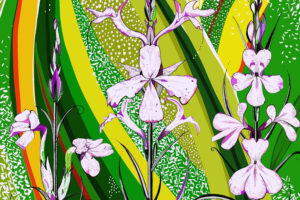 Striga is a devastating parasitic weed that attacks food crops in sub-Saharan Africa such as rice, sorghum and millet.
Striga is a devastating parasitic weed that attacks food crops in sub-Saharan Africa such as rice, sorghum and millet.
It affects 40% of Africa’s arable savanna region, and is a major cause of food insecurity and poverty. At its worst, it can lead to farmers losing their entire crop.
Tackling plant health problems experienced by rural subsistence farmers requires an extra level of local collaboration and ingenuity. This is to ensure that solutions are locally appropriate and meet the needs of these communities.
Professor Scholes, The University of Sheffield, who is researching new ways to combat the weed, said:
The parasitic weed Striga causes devastating losses in cereal yields in sub-Saharan Africa. The parasite lifecycle is intimately linked with its host via a complex interchange of signals.
Understanding the molecular basis of these interactions and of host resistance to Striga is essential for the identification of genes for improving crop yield.
Libby Walker is an illustrator and maker based in Glasgow.
Himalayan balsam
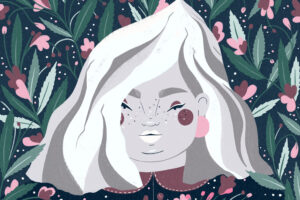 It’s not just cultivated plants that are under threat from plant health issues. Wild plants and ecosystems are also at risk.
It’s not just cultivated plants that are under threat from plant health issues. Wild plants and ecosystems are also at risk.
Himalayan balsam (Twitter) is a garden plant that was introduced to the UK in the 1800s and spread from gardens into the wider environment.
The plant has spread all over the UK along riverbanks, where its dense thickets outcompete native species. It reduces native species diversity by 25% in areas where it covers the riverbanks.
The UK Environment Agency has estimated it would cost between £150 to 300 million to eradicate Himalayan balsam from the UK.
As climate change progresses, it’s likely to spread further north. However, some wild plants are set to lose out from warmer temperatures and shrink their ranges.
Tara O’Brien is an illustrator from Dublin. Her personal work has a focus on diverse representations of people, body politics and mental health.
After researching the plant, the characteristics, I knew I wanted to incorporate into the piece the density and speed at which the Himalayan balsam grows.
When exploring the natural world in my work, I’m always drawn to showing it through a human lens, either through a character’s interaction or by creating a human embodiment of the subject.
This allows me to inject a greater sense of personality to the work, which made the process of finding that character very engaging and enjoyable for this particular brief.
Ash tree
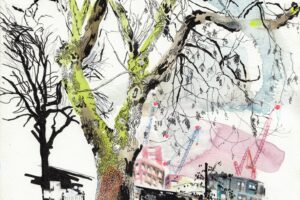
Tree disease has dramatically changed landscapes and ecosystems in the UK. Today, one of the most common trees in the UK, the iconic ash tree, is at risk from a threat called ash dieback.
Ash is an important tree in woodlands as its diffuse canopy allows light through to the woodland floor, allowing the growth of other plants at ground level.
We need to avoid another catastrophic loss of trees, and all the species that depend on them. Researchers from across disciplines have worked together to tackle the problem from all sides, including investigating the biology of the pathogen and motivating the human behaviours needed for change.
The Nornex partnership, named after the Norns, who guarded the mythical Norse ash tree Ygdrasil, brought together scientists from eleven institutions.
This aimed to understand the disease and to identify and develop ash trees which are less susceptible to ash dieback. These trees will hopefully survive to ensure that ash remains part of the UK landscape.
Susanna Davies is an artist and illustrator based in London. She is known for her #HackneyTreeHundred project, documenting 100 trees around the capital in pen, ink and watercolour.
I firmly support this campaign. I chose to draw this particular tree in light of its history, fame and uncertain future. Set in St. Pancras old churchyard in London, it is surrounded by stacked gravestones.
The famous novelist, Thomas Hardy, then an architect’s apprentice, oversaw the exhumation of gravestones here, due to the railway being built through this graveyard in the 1860s. Thus it is nicknamed, “The Hardy Ash,” being true to its name and rising out of these redundant tomb stones.
Brussels sprouts
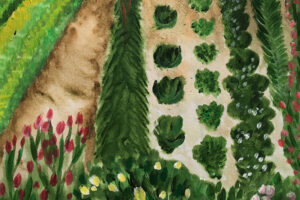 Brussels sprouts are part of a varied but closely related family called the brassicas, which also includes cauliflower and broccoli.
Brussels sprouts are part of a varied but closely related family called the brassicas, which also includes cauliflower and broccoli.
We use brassicas for everything from fuel (oilseed rape) to condiments (mustard), as well as the leafy vegetables which are so good for us.
But brassicas are very sensitive to weather conditions, which are becoming more unpredictable as the climate changes.
Flooding in the summer of 2019 led to the threat of a shortage of Brussels sprouts for the Christmas season.
UKRI is supporting work to make brassicas more resilient to varied weather, reducing waste and environmental impact.
One example is Brassica, Rapeseed and Vegetable Optimisation, a five year £4.4 million investment from BBSRC (John Innes Centre) This project, started in 2017, will help to:
Develop new, more resilient varieties of brassica crops that can achieve superior field performance while reducing yield loss and industry wastage.
Lorna Jenkins is an artist and illustrator from Gloucestershire. She paints impressionist landscapes and nature. She also works as a Senior Content Manager at UKRI.
I’ve loved working on this project, finding out how vital plants are to our everyday life, and how UKRI plays a leading role in ensuring future plant health. As an artist in my spare time, I also couldn’t resist joining in on creating an artwork.
Cabbages, kale and sprouts are quite a common choice in the UK’s vegetable patches and allotments, and are some of the few things left growing at this time of year, so I decided to show them in a cottage garden.
Last updated: 10 June 2025
